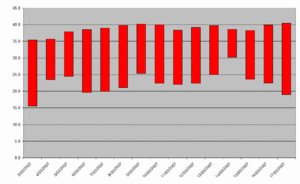- Climate of Adelaide
-
Adelaide Climate chart (explanation) J F M A M J J A S O N D 192917122917252615412312601910801687615767178601910442211322514282716Average max. and min. temperatures in °C Precipitation totals in mm Source: Bureau of Meteorology [1] Imperial conversion J F M A M J J A S O N D 0.784630.58563179591.673542.466503.16147360452.662472.466491.771531.377571.18160Average max. and min. temperatures in °F Precipitation totals in inches Adelaide has a hot Mediterranean climate (Köppen climate classification Csa)[2], which generally means mild, wet winters and hot, dry summers. Of all the Australian capital cities, Adelaide is the driest. Rainfall is unreliable, light and infrequent throughout summer. The average in January and February is around 20 millimetres (0.8 inches) but completely rainless months are by no means uncommon and in 1893 sixty-nine days passed without measurable rainfall. In contrast, the winter has fairly reliable rainfall with June being the wettest month of the year, averaging around 80 mm.
In the summer, maximum average is 29 °C (84 °F) but there is considerable variation and Adelaide can usually expect around 3 days a year when the daytime temperature is 40 °C or above. In January 1939, the temperature reached 46.1 °C (115.0 °F) twice. From 3 March 2008, Adelaide recorded 15 consecutive days of temperatures over 35 °C, again a record for an Australian capital. In winter from June to August, maximum average is 15–16 °C (59–61 °F) and minimum is usually around 8 °C (46 °F). Frosts are common in the valleys of the Adelaide Hills, but rare elsewhere, with the most notable occurrences having occurred in July 1908 and July 1982. There is usually no appreciable snowfall in Adelaide, except on rare occasions at Mount Lofty and in some places in the Adelaide Hills.
Climate data for Adelaide (Kent Town, 1977-2010) Month Jan Feb Mar Apr May Jun Jul Aug Sep Oct Nov Dec Year Average high °C (°F) 29.2
(84.6)29.4
(84.9)26.4
(79.5)22.6
(72.7)19.0
(66.2)16.1
(61.0)15.3
(59.5)16.7
(62.1)19.0
(66.2)21.8
(71.2)25.1
(77.2)27.0
(80.6)22.3 Average low °C (°F) 17.0
(62.6)17.2
(63.0)15.2
(59.4)12.4
(54.3)10.2
(50.4)8.1
(46.6)7.5
(45.5)8.2
(46.8)9.7
(49.5)11.4
(52.5)14.0
(57.2)15.5
(59.9)12.2 Rainfall mm (inches) 19.3
(0.76)12.4
(0.488)24.9
(0.98)40.9
(1.61)60.0
(2.362)79.7
(3.138)75.8
(2.984)66.7
(2.626)60.3
(2.374)44.3
(1.744)31.7
(1.248)28.0
(1.102)542.3
(21.35)Avg. rainy days 2.8 2.0 3.4 5.4 9.0 11.1 12.0 11.7 9.3 6.8 4.8 4.4 82.7 Sunshine hours 325.5 285.3 269.7 216 167.4 138 148.8 189.1 204 257.3 273 294.5 2,768.6 Source: Bureau of Meteorology [1]
Recorded extremes:- Hottest temperature – 12 January 1939, 46.1 °C (115.0 °F)
- Coldest temperature – 8 June 1982, −0.4 °C (31.3 °F)
- Wettest month – June 1916, 217.9 mm (8.58 in)
- Hottest Minimum- 33.9°C, 28- 29 January 2009
(Records from West Tce weather station 1839-1977 & Kent Town weather station 1977-present)
Contents
2008 Heatwave (2- 17 March 2008)
Between 3 March and 17 March 2008, Adelaide recorded consecutive maximum temperatures of 35C or above in what was the longest heatwave recorded in an Australian capital city.
2009 Heatwave (26 January 2009- 3 February)
On 25 January 2009, the city was affected by the 2009 Southern Australia heat wave, due to a virtually stand-still high pressure system that dragged northerly air streams towards the city. The heatwave broke numerous records and has affected all of south-eastern Australia, including Melbourne, another southern Australian city, cancelling outdoor games during the 2009 Australian Open. The heatwave commenced on Australia Day 2009 with temperatures above 35 degrees Celsius. From 27 January onward the temperature has soared above 40 degrees for 3 consecutive days with another 3 days planned and no temperatures below 40 until at least 2 February where the temperature is expected to reach 39 degrees Celsius. This would be the longest straight run of 40 degrees Celsius plus temperatures in Australian history. On 28 January, the third day into the heatwave, the temperature soared to 45.7 degrees Celsius, making it the 3rd hottest day on record in Adelaide. On that same night, the temperature only dipped to 33.9 degrees Celsius making it the highest minimum temperature on South Australian record.
November 2009 Heatwave
The November 2009 heat wave was a heat wave that occurred in the Australian states of South Australia, Victoria and southern New South Wales. Daily maximum temperatures during the heat wave were roughly 10 °C (18 °F) above average in many locations. Capital cities Adelaide and Melbourne recorded temperatures over 35 °C (95 °F), and some regional towns recorded temperatures above 40 °C (104 °F). Above average temperatures in the region began in late October and persisted until mid-November 2009.
- 10 Consecutive days over 30 °C (86 °F)
- 8 Consecutive days over 35 °C (95 °F) – New record set on 12 November 2009 and broken again on 13 November after breaking the previous 4 consecutive days over 35 °C (95 °F) record which was set in 1894.[3]
- 6 Consecutive days over 38 °C (100 °F) – New record set after breaking the previous 3 consecutive days over 38 °C (100 °F) record which was set in 1888, 1922 and 1984.[4]
- Highest November temperature ever recorded – 43.0 °C (109.4 °F) 19 November 2009 at 4:32pm ACDT. Previous record was 42.0 °C (107.6 °F) recorded on 13 November 1993.[5]
References
- ^ a b "Climate statistics for Australian locations - Monthly climate statistics - Period 1977-2010 - Summary statistics ADELAIDE (KENT TOWN)". Commonwealth of Australia, Bureau of Meteorology. http://www.bom.gov.au/climate/averages/tables/cw_023090.shtml. Retrieved 16 February 2010.
- ^ Tapper, Andrew; Tapper, Nigel (1996). Gray, Kathleen. ed. The weather and climate of Australia and New Zealand (First ed.). Melbourne, Australia: Oxford University Press. p. 300. ISBN 0195533933.
- ^ "Adelaide sweats in landmark heatwave". ABC News Online. 12 November 2009. http://www.abc.net.au/news/stories/2009/11/12/2740805.htm. Retrieved 12 November 2009.
- ^ Dutschke, Brett (12 November 2009). "Little relief from record heat in SA". Weatherzone. http://www.weatherzone.com.au/news/little-relief-from-record-heat-in-sa/13049. Retrieved 12 November 2009.
- ^ "Adelaide, South Australia November 2009 Daily Weather Observations". Bureau of Meteorology. http://www.bom.gov.au/climate/dwo/200911/html/IDCJDW5002.200911.shtml.
Categories:- Adelaide
- Climate by city
- Climate of Australia
Wikimedia Foundation. 2010.

